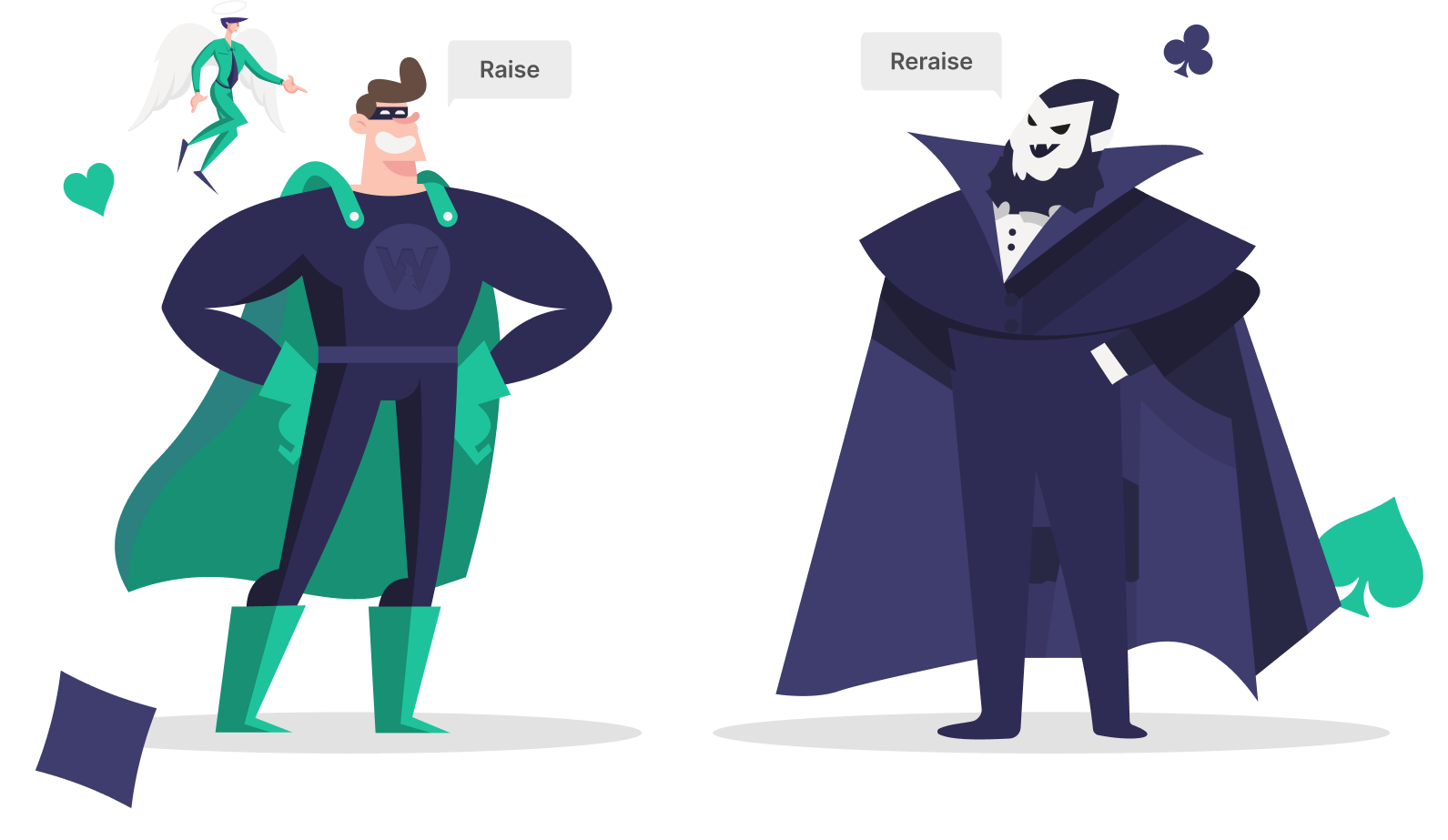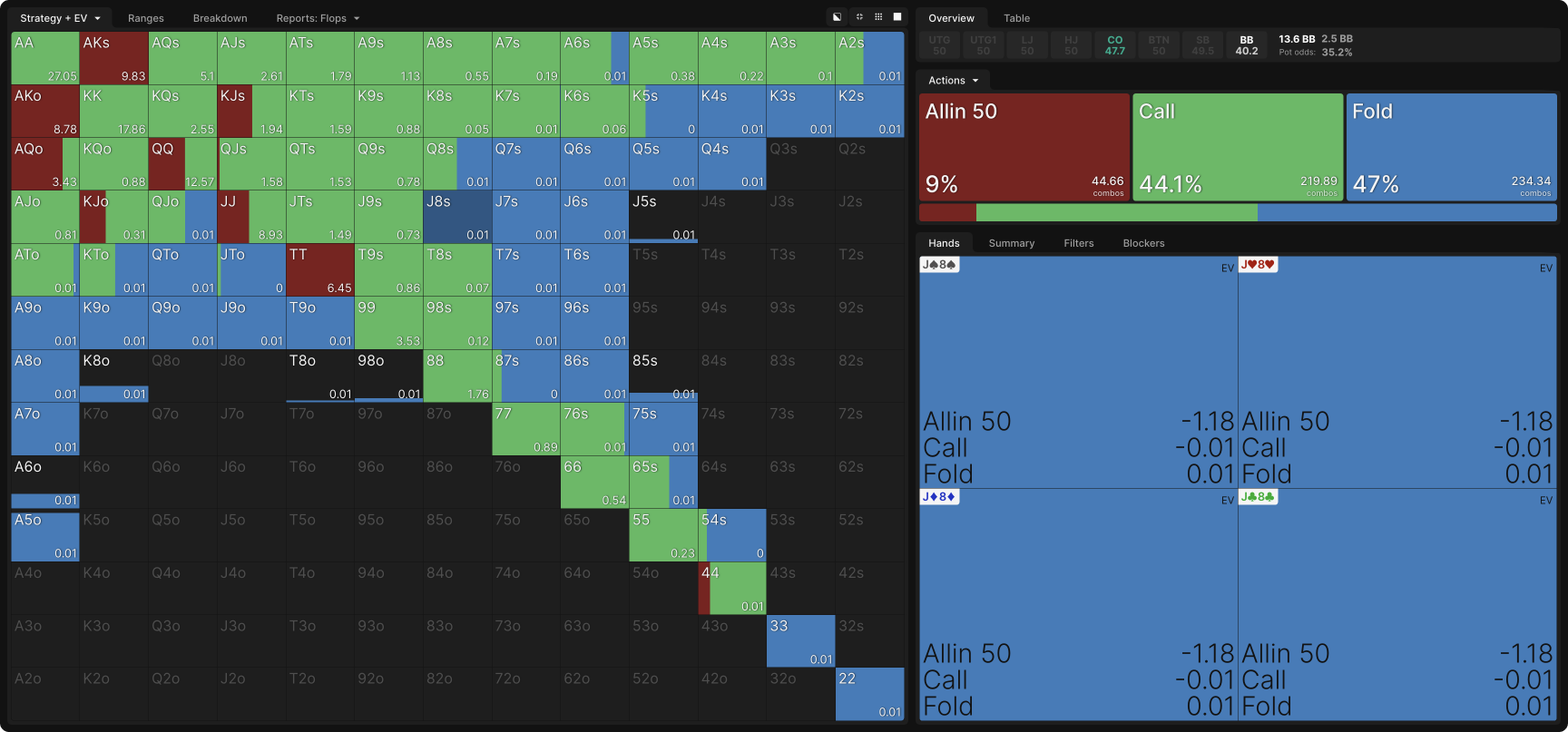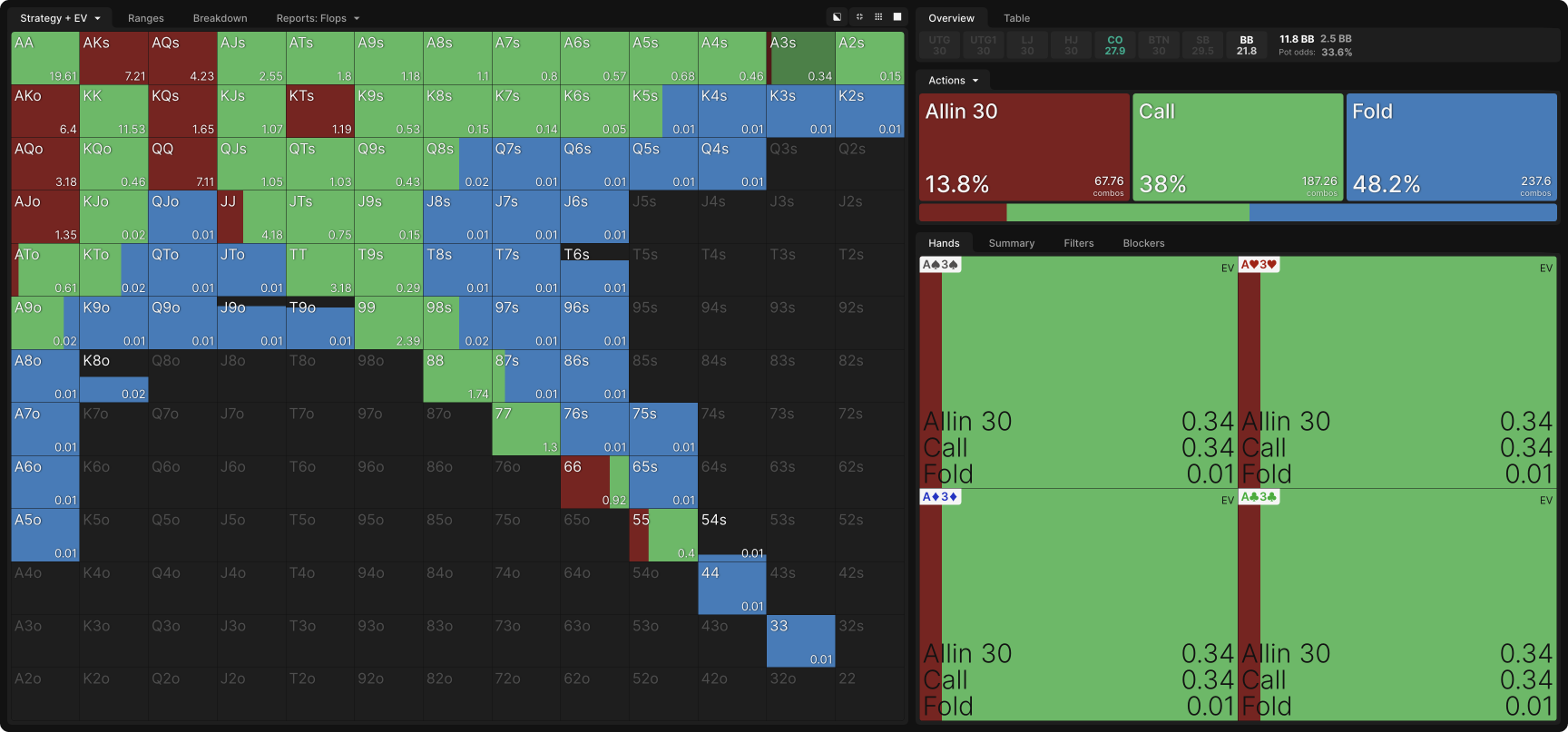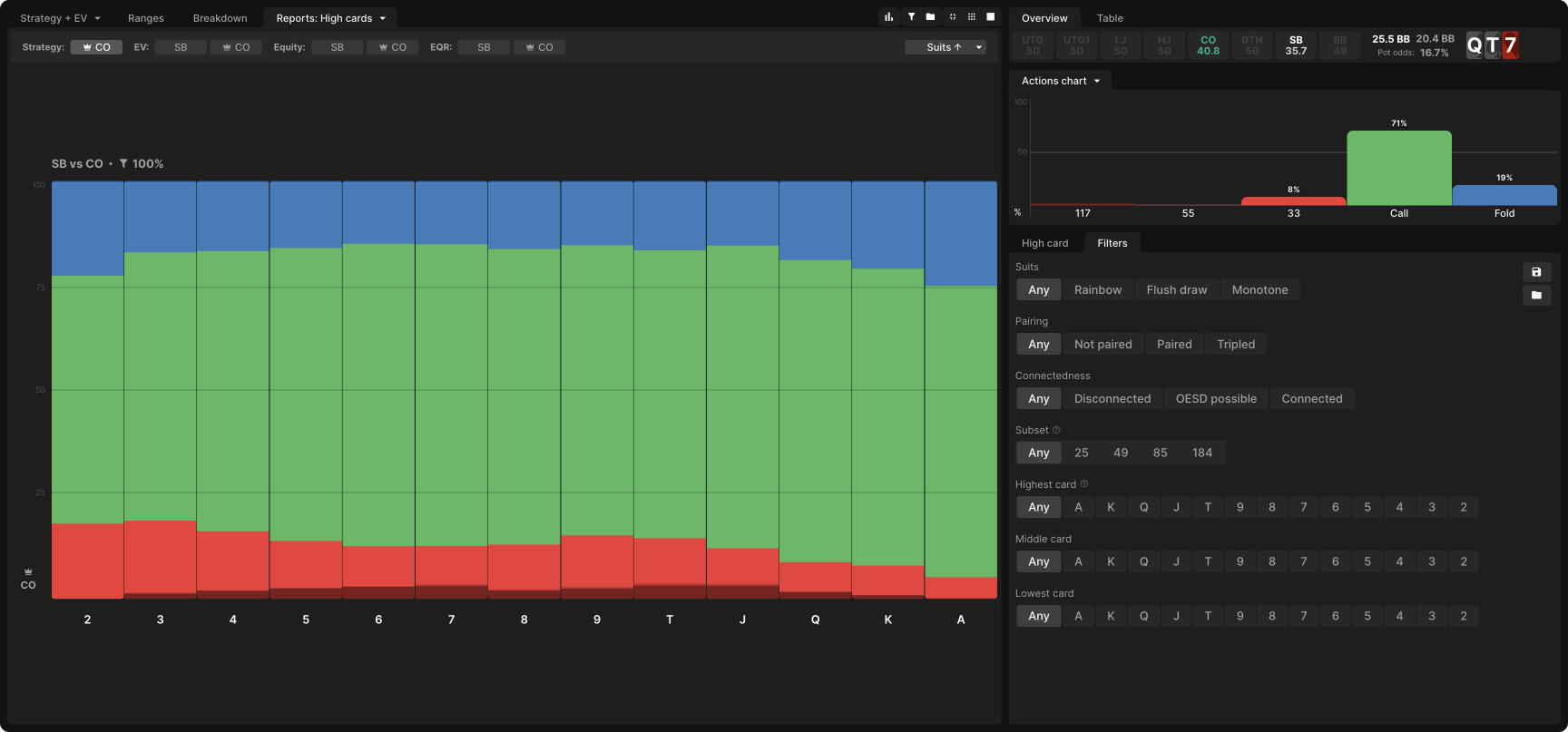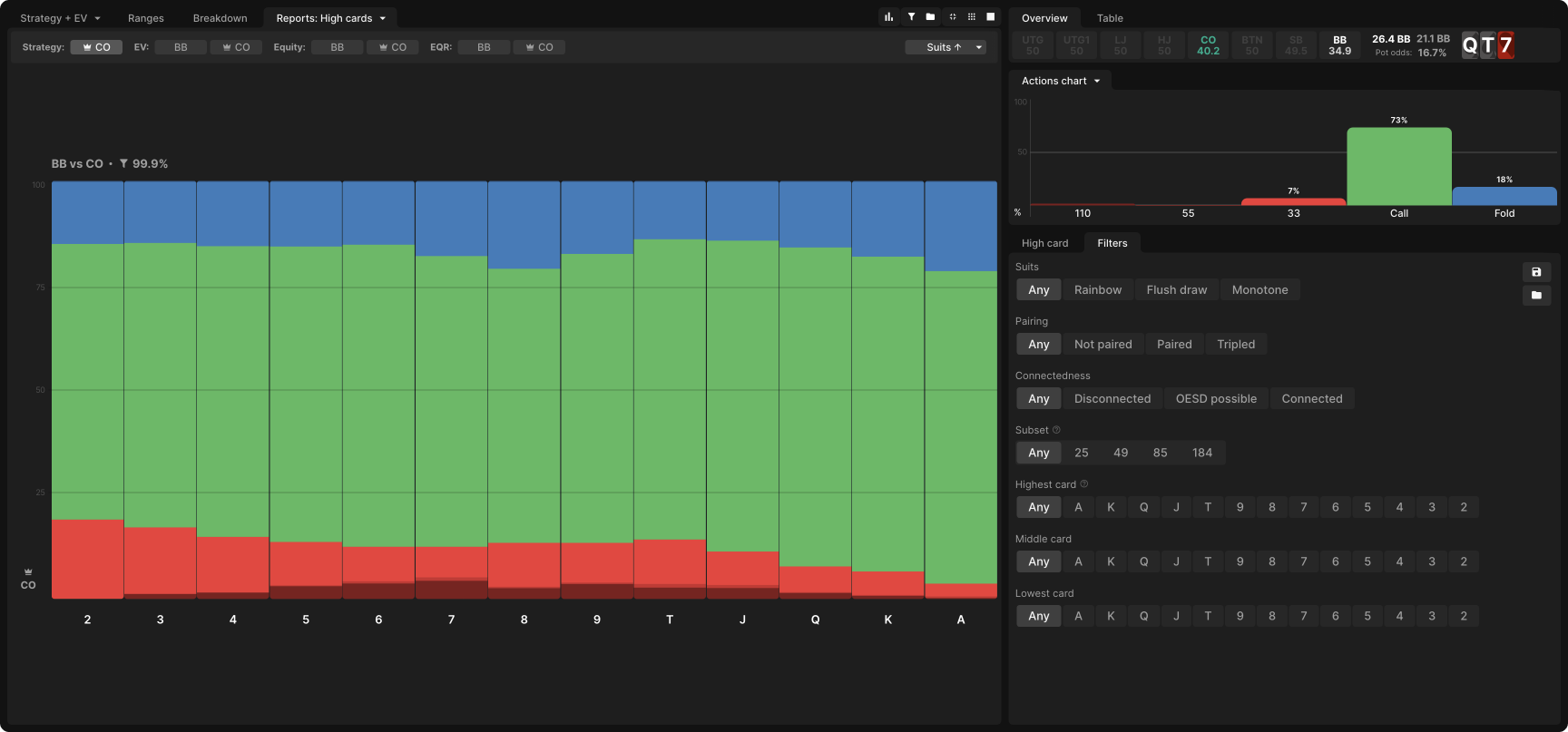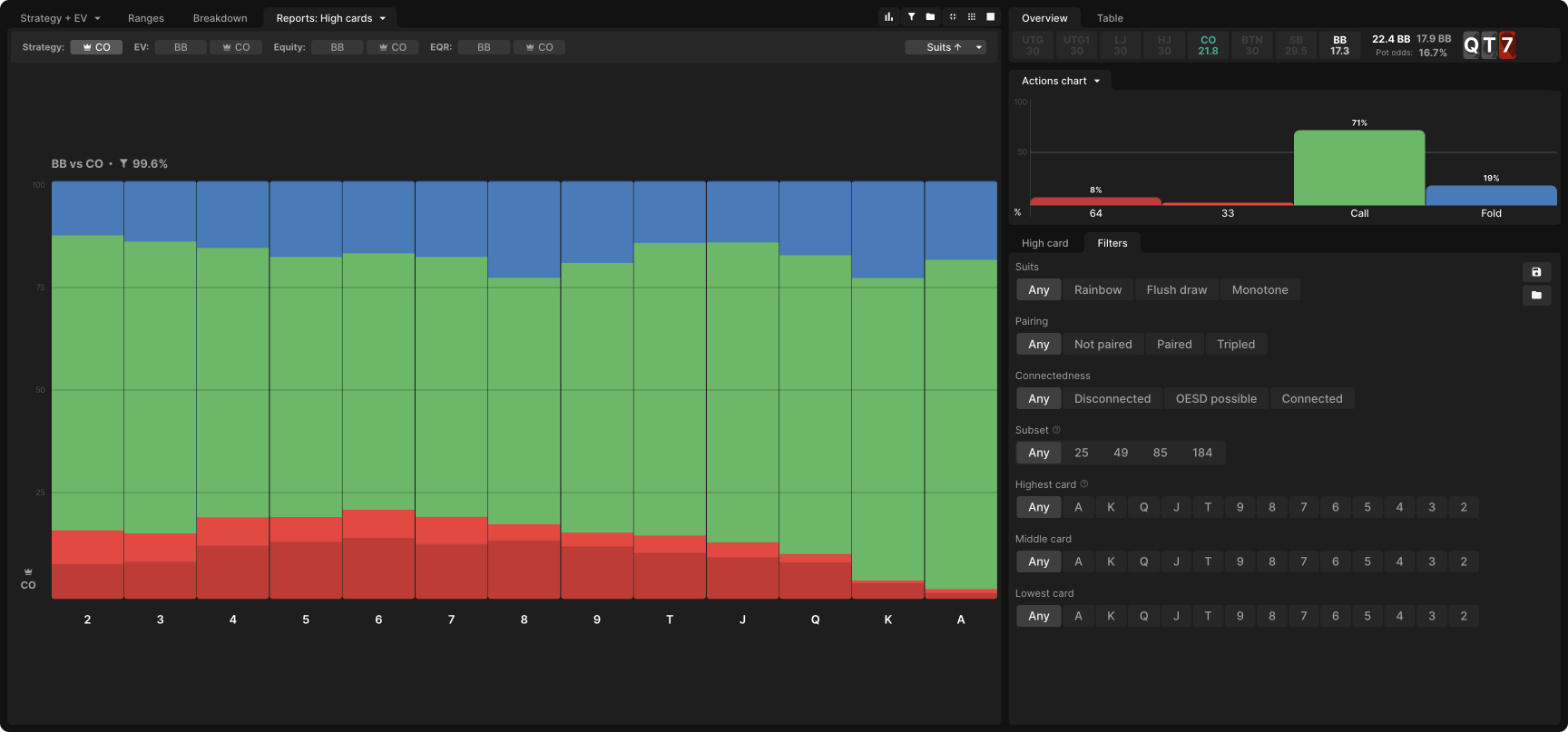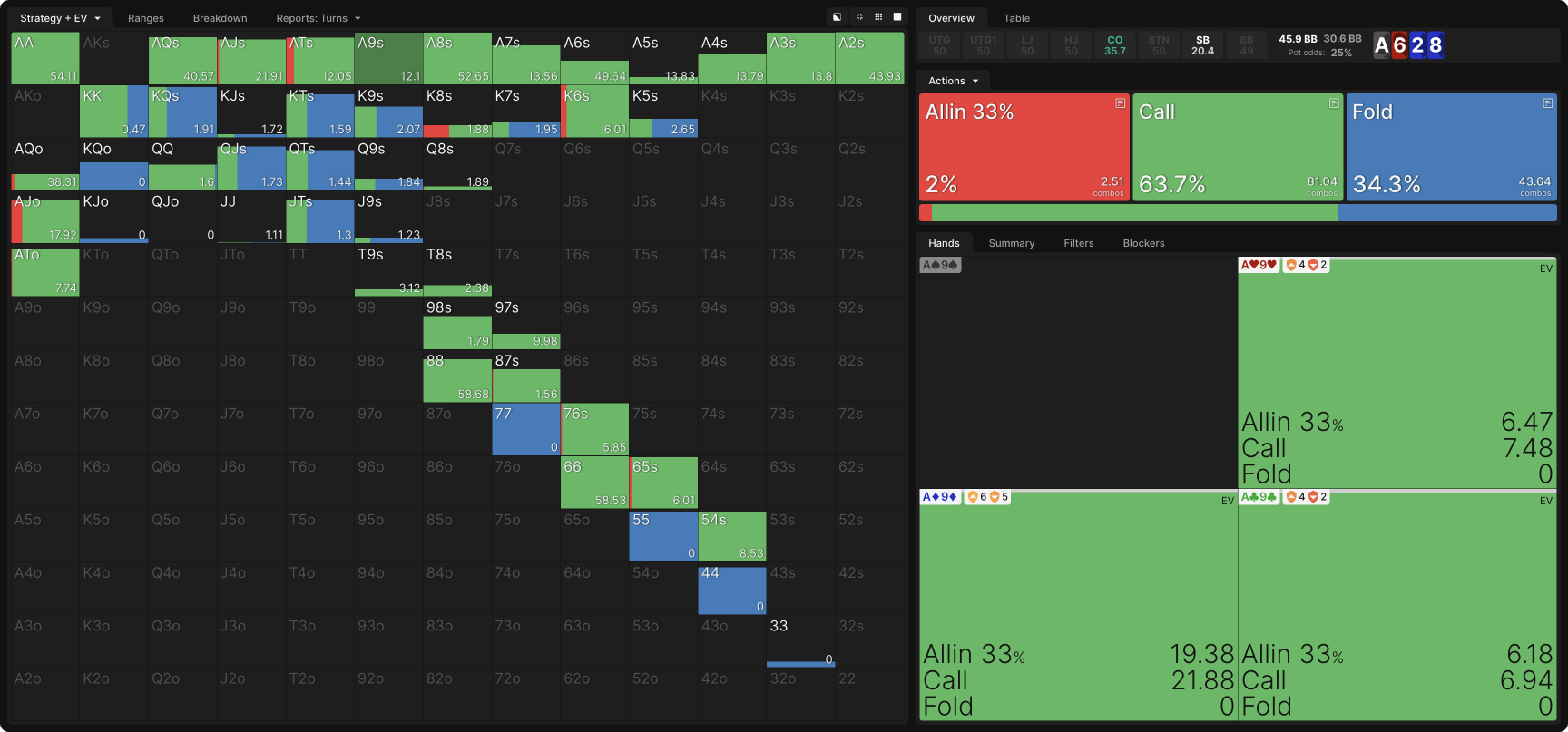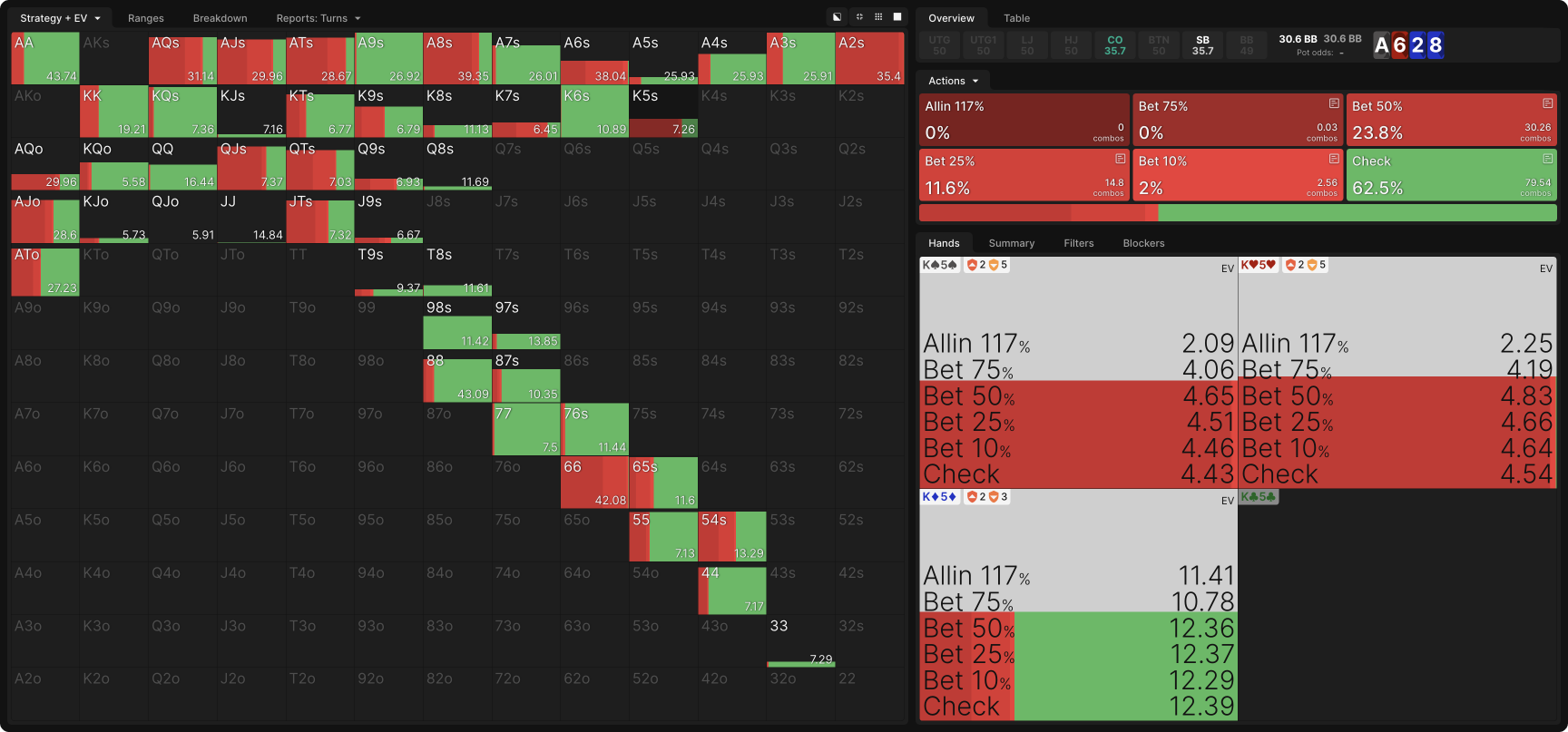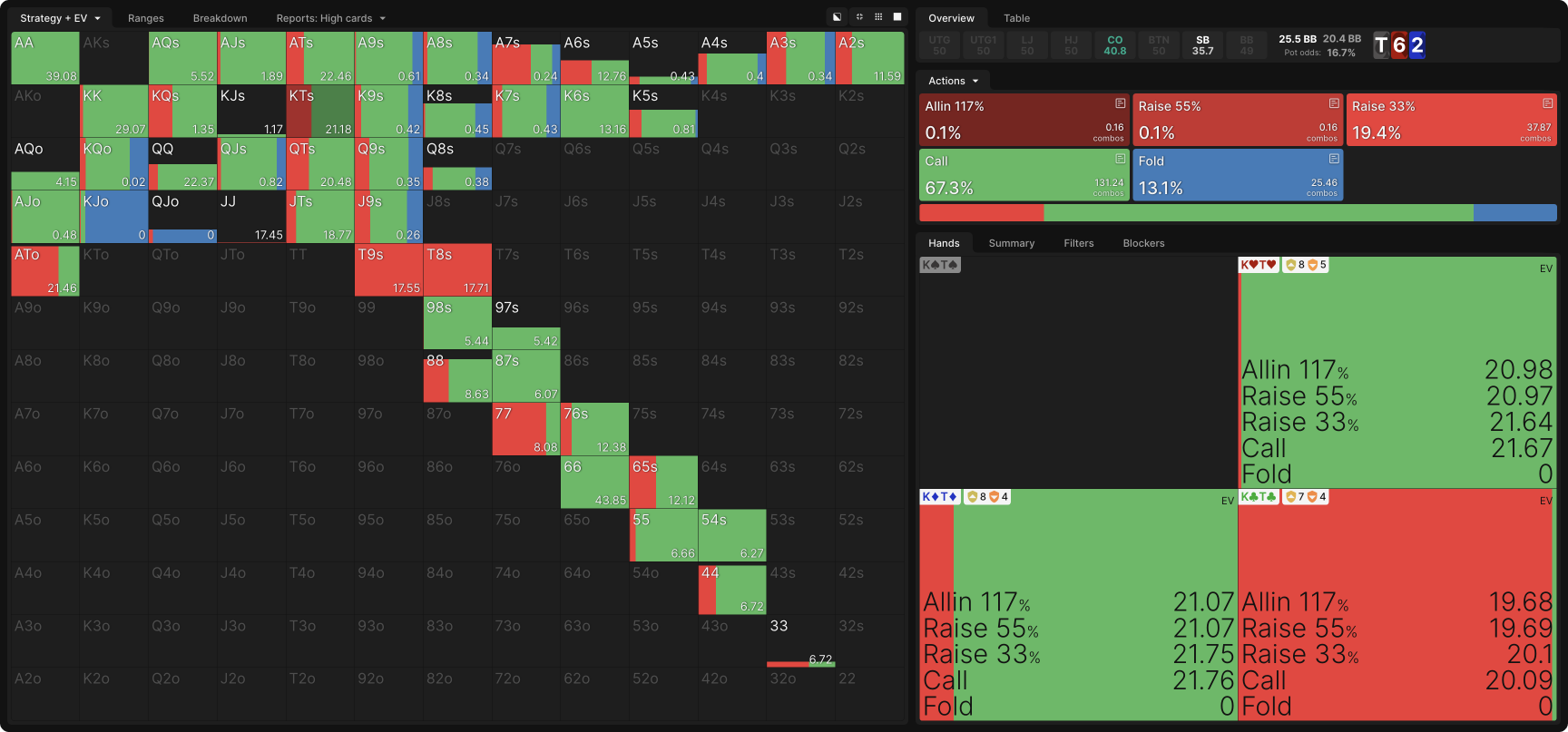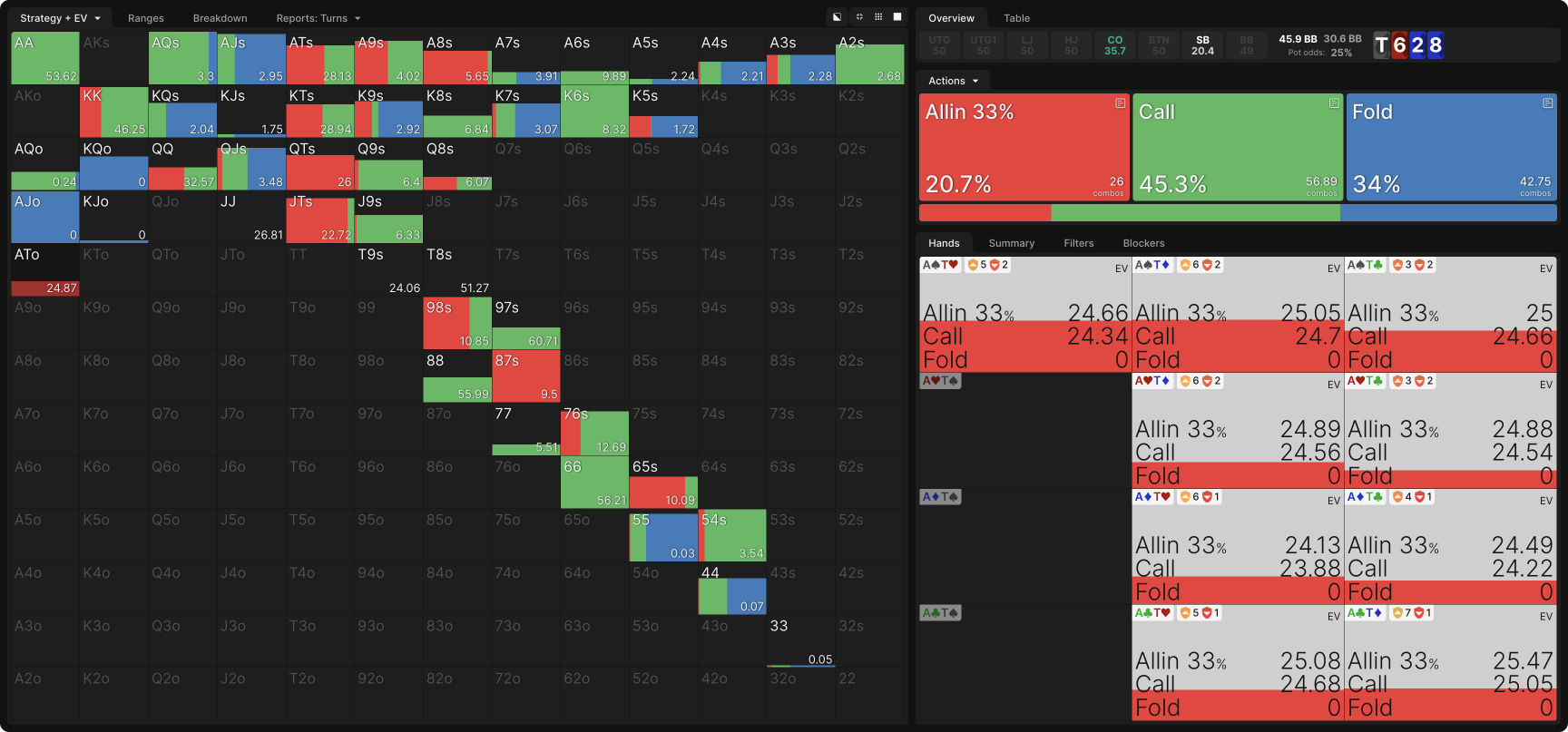Mastering Three-Bet Pots In Position in MTTs
Playing in position against a three-bettor is a lesson in playing to your advantages. As the defending player, you will not have the equity advantage or the nuts advantage.
What you will have is the positional advantage. This incentivizes you to play even more passively than you usually would as the defending player facing aggression, forcing your opponent to make tradeoffs and reveal information by acting first on future streets while you bluff, pot control, and squeeze extra value from marginal hands.
Deeper stack depths magnify your positional advantage, as do more dynamic boards, so you’ll need to assess these factors to determine the incentives of your specific hand in any given situation.
Playing Before the Flop
The following chart shows the CO’s response to a three-bet from the blinds at various stages of the tournament, always with 50bb stacks. The numbers are slightly different when the open comes from other positions, but the patterns are the same.
The patterns are different if someone has called the open raise and then one of the blinds has squeezed. More tight and aggressive play is generally correct in that scenario, as described in this article.
Calling is an important part of your strategy even under ICM pressure, which incentivizes more tight and aggressive play. A higher risk premiumRisk premium
Risk Premium measures the extra risk you take stacking off in an MTT. It’s a measure of survival pressure and a valuable tool for understanding ICM spots. Risk premium is defined as the extra equity you’d need to call someone’s shove, compared to a (chip EV) pot odds calculation. RP = Required Equity (ICM) – Required Equity (cEV) when stacks are fully invested. Each player has a unique risk premium against every other player in a tournament. results in less calling, more folding, and more raising, as is to be expected. But the magnitude of these differences varies dramatically depending on whether the three-bet comes from the SB or the BB, which is perhaps more surprising.
Your response to a three-bet heavily depends on whether the three-bet comes from the SB or the BB.
Indeed, there are several notable differences in how CO responds to a SB three-bet versus a BB three-bet. Across the board, they fold more and four-bet less against the BB. Their response to a BB three-bet does not change that much at various stages of the tournament, especially not compared to how much their response to a SB three-bet changes.
Responses versus BB three-bets stay relatively stable compared to responses versus SB three-bets.
This reflects differences in the ranges, raise sizing, and incentives of the three-bettor.
For the SB, calling is a less appealing option. They are getting only a small discount from their small blind, and they are not closing the action. Thus, they three-bet a more linearLinear
A range construction that consists of the top-down strongest hands. A linear range might contain nutted to medium strength hands, or value to thin value. range, including many hands that would otherwise play well as calls preferring to deny equity to the BB. This is especially true as ICM pressure increases.
For the BB, calling is very appealing. They are getting amazing odds, thanks to their big blind and the ante, and they do not have to worry about anyone calling or raising behind them. When they do three-bet, they prefer to do so with a more polarPolarized
Describes a range that is mainly very strong made hands or bluffs, with very few middle strength hands. range consisting of very strong hands that will be happy to get all-in preflop and hands so weak they are not especially appealing calls. Thus, they are less likely to have a tough decision when faced with a four-bet. This more polar range incentivizes BB to use a larger size when they three-bet as well, so it is correct for the opener to fold hands they would not fold to the SB.
The other interesting trend here is that CO’s calling frequency goes up as the stacks get deeper. This is the opposite of what happens when the opener faces a three-bet from an in position player, which provides a clue as to what is going on here.
Playing after the flop is good for the player in position. The more money remaining to be wagered, the more their position is worth. Thus, the out of position player—at deeper stack depths—has more incentive to avoid playing postflop by either folding or four-betting. As stacks get shallower, it matters less and less that they are out of position, which makes it increasingly appealing for them to take advantage of the pot odds by calling and seeing a flop with hands that would have folded if stacks were deeper.
Playing after the flop is good for the player in position.
Conversely, CO prefers not to end the hand preflop when stacks are deep because they expect to over-realize their equity postflop. They call with some weaker hands that they would fold with shallower stacks but also with some surprisingly strong hands that would four-bet if stacks were shallower. Here’s their full strategy when facing a three-bet from the BB with 50bb stacks and no ICM considerations:
Suited and connected hands are best equipped to profit from the additional stack depth. Not only is the reward for making a straight or flush higher, but deeper stacks also enable these hands to apply more pressure when floating and semi-bluffingSemi-bluff
A bet made with an unmade hand (such as a draw) that has the chance to improve on future cards. their draws.
Even some more offsuit broadway hands can call against the blinds which would not call against the BTN, hands like ATo, which often turn into top pair with a modest kicker or middle pair. Position makes it easier to keep the pot small and/or get away when dominated, and to get to showdown and maybe even squeeze out some additional value when ahead.
A lower SPR incentivizes the opener to protect their equity when ahead rather than call to potentially win even more after the flop.
With shallower stacks, these big offsuit hands go up in value, while the smaller suited cards go down. If we shrink the stacks from 50bb to 30bb, CO’s folding frequency doesn’t change much, but the composition of the continuing range changes a bit. Smaller pairs and suited connectors now fold while offsuit hands like A9o and KTo call more often:
The biggest change we see is more shoving from hands like AQs, AJo, and QQ. CO’s shoving frequency increases by about 50%, as the lower SPR incentivizes them to protect their equity when ahead rather than call to potentially win even more after the flop from dominated hands.
Facing a Continuation Bet
After calling a three-bet, you will likely face a small continuation bet on the flop. This is by far the most likely action for both a SB and BB three-bettor. With shallower stacks, they show a strong preference for betting 25% pot. With deeper stacks, they make many 50% pot bets as well, but your response to both is similar.
CO Response to 25% C-Bet From SB in Three-Bet Pot with 50bb Stacks
You should mostly call. Raising is a bigger part of your strategy on low card boards, which are more dynamic, but calling is always your most frequent action. Just like before the flop, playing poker on later streets favors the in position player, so you generally prefer that to ending the action on the flop.
More cards coming down also tend to be worse for the preflop raiser because the big advantage they have over the caller is a prevalence of big pairs in their range. The more cards on the board, the weaker these big pairs tend to be. This is less true on low card boards because the three-bettor also has many unpaired overcards, which could easily become stronger as a result of the turn or river card. This is part of why the CO plays more aggressively on these boards.
The pattern is similar when playing against BB:
And with shallower stacks:
Playing a Static Flop
A62r is a good example of a board where, even at 50bb, the three-bettor prefers a small continuation bet, and the caller virtually never raises.
CO actually does not hit MDF on this flop, despite some ambitious floats with hands like KJo and T8 with a backdoor flush draw. Ace-high boards are very good for the three-bettor, especially when they don’t offer many draws, so CO just has to take the ‘L’ with their worst hands.
Facing a second 50% barrel on the turn, CO’s strategy is fairly intuitive: they call with any draw and most pairs but fold their whiffed floats and worst pairs, which are the low pocket pairs that now have just two outs to improve on the river.
More commonly, however, they will face a check on the turn, and that’s where things get interesting. On this board, CO starts betting geometrically with a polarized range. A strong top pair or better is the threshold for value, while their bluffs come not only from flush draws (many of those prefer to check back so as not to open themselves up to a raise) but from whiffed floatsFloats
To call a bet postflop with a weak hand with the intention of bluffing on a later street to win the pot.:
You can see in the example above that K♦ 5♦, which turned a flush draw, is indifferent between betting and checking, but K5 in the other backdoor flush suits are pure bets.
Playing a Dynamic Board
Changing the Ace to a Ten makes the situation much more dynamic. Especially in a three-bet pot, ranges are concentrated around big cards, so when there is a big card—especially an Ace—on the flop, both players will flop a good number of strong hands that are relatively hard to draw out on. When there is no such card, then both will flop many hands with the potential to improve on future streets, which makes protection and equity denial bigger considerations.
In a three-bet pot, ranges are concentrated around big cards.
Facing a 25% continuation bet on this board, CO raises aggressively, with a strong preference for protecting their weaker top pair hands. These hands are strong enough to get all-in now but will lose value on many turns.
They also fold quite rarely. Even with this robust continuing frequency, SB can profitably bet any two cards. This is because, with the more dynamic board, SB has no pure bluffs, hands with effectively 0 showdown value or potential to improve. Nor does CO have many hopeless hands. Getting five-to-one odds, most hands can justify taking one off in position.
On the 8♦ turn, CO’s continuing strategy mostly follows the same logic as on the A62r board, though as on the flop, they have a more robust raising range consisting mostly of strong but vulnerable pairs (A8 is good enough to fit this bill):
The trickiest bit here is probably the call with AQ, even when it does not have a diamond. Calling with smaller pairs can feel dicey as well, given the risk of a scary river card and/or bet.
These plays are easier to conceptualize and execute if you keep in mind the following three factors:
- Your gut is right; you’re probably going to lose. These are your weakest calls, and against an equilibrium strategy, they are barely profitable. That means, getting 3:1, you’re going to claim about a quarter of the pot with them, whether that be by showing down the best hand or bluffing or value betting. These calls are nevertheless correct because of the price. (Things become more precarious when ICM is a factor, which is why you don’t call as much preflop in the first place.)
- These hands work together, along with your position and traps (note that there are lots of AA and KK in your calling range as well), to give your opponents tough decisions on the river. Did the Ace just give you top pair, or did it crush the hopes of your 55? Should they bluff a blank river to get you off your AQ? If they do, they risk running into your slowplays or the small pairs, which are a bit stronger now that they know no big cards have come.
- Your opponent will also have many medium-strength hands of their own that want to check or block-betBlock bet
A small bet made by the out of position player designed to prevent or “block” the opponent from betting themselves. Sometimes used to induce raises. the river. Your lighter calls give you surprising value bets on some rivers and weak hands to bluff with on others, making your out of position opponent’s life difficult.
Conclusion
Playing against the strong range of a three-bettor is always intimidating, but having position is a big help. It also helps to remember that your objective is not to maximize your chances of winning the pot. Instead, it’s to make the most money. You have the weaker range and should expect to lose more pots than you win, which is fine because you were getting a good price to call before the flop.
Rather, your goal is to give your opponent difficult decisions. When you call, as you often should both before and after the flop, they don’t know whether you are slowplaying or floating or desperately hoping for a cheap showdown with a marginal pair. Nor will they know whether that flush card or overcard on the turn just made your hand or wrecked it.
This, in turn, makes it difficult for them to determine whether they should bet again, check and call, or check and fold. Sometimes they’ll guess right, but they’ll rarely be sure of the right play, and that’s the best you can hope for.
Practice
These drills have you facing a three-bet from the blinds from various seats and stack sizes. They are all based on ChipEV simulations so that you can practice both preflop and postflop decisions.
If you want to practice incorporating ICM into your decisions, these ICM drills put you in similar preflop spots (postflop simulations based on ICM models are not yet available) with 50% of the field remaining. Once you’ve got the hang of that, you can tweak the parameters to practice other stages of the tournament, but you’ll likely get more out of focusing on one stage at a time rather than training on a set of drills that randomly draws from many different ICM models.
These drills have you facing a three-bet from the blinds from various seats and stack sizes. They are all based on ChipEV simulations so that you can practice both preflop and postflop decisions.
If you want to practice incorporating ICM into your decisions, these ICM drills put you in similar preflop spots (postflop simulations based on ICM models are not yet available) with 50% of the field remaining. Once you’ve got the hang of that, you can tweak the parameters to practice other stages of the tournament, but you’ll likely get more out of focusing on one stage at a time rather than training on a set of drills that randomly draws from many different ICM models.
Author
Andrew Brokos
Andrew Brokos has been a professional poker player, coach, and author for over 15 years. He co-hosts the Thinking Poker Podcast and is the author of the Play Optimal Poker books, among others.
